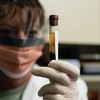Triglycerides and cholesterol refer to two different types of lipids that are stored in the blood. As lipids, cholesterol and triglycerides share many qualities. They are hydrophobic, meaning they would rather repel water than absorb it. At high levels, both can indicate health conditions such as stroke or heart disease. But the two lipids have differences in function, benefits and side effects.
Triglycerides
Triglycerides are the basic chemical form of fat. Chemically, the structure of triglycerides is one molecule of glycerol (CHOH2-CHOH-CHOH2) attached to three fatty acids, such as oleic acid or linoleic acid. Triglycerides come from either ingestion of dietary fats or through the conversion of unused calories. Triglycerides are stored in the body's fat cells until the body needs to metabolize them for energy.
Benefits and Side Effects
Excess triglyceride levels, or hypertriglyceridemia, can contribute to coronary artery disease. Higher levels of triglycerides can indicate poorly controlled type 2 diabetes, hypothyroidism, liver disease or kidney disease. At normal levels, triglycerides are important in the production of energy for most cells in the body, except brain cells, and can be broken down to help build other cells.
Cholesterol
Cholesterol, with a chemical structure is C27-H4-OH, acts as both a precursor for hormones and as a part of cellular membranes. The human body produces 2 grams of cholesterol per day, making up about 85 percent of blood cholesterol levels. The other 15 percent comes from a person's diet. Most cholesterol from diet comes from oils and fats in foods. The body produces bile acids from cholesterol; bile acids break down oils and fats. The blood transports cholesterol by lipoproteins, which easily clump together with fats. The two different types of lipoproteins are low-density lipoproteins (LDL) and high-density proteins (HDL).
Benefits and Side Effects
Cholesterol is important for the production of estrogen in women, testosterone in men and processing vitamin D. Many cells use cholesterol as insulation to keep a cell fluid and functioning in cold temperatures. Too much cholesterol can increase LDL production while decreasing HDL production. Excessive LDL builds up on arterial walls and hardens to create plaque, constricting flow and contributing to heart disease. HDL removes excess cholesterol from the body.
Proper Health
A visit to your doctor for a complete fasting lipoprotein profile will inform you of your body's LDL, HDL and triglyceride levels. According to the American Heart Association, your body should have less than 150 mg of triglycerides and 100 mg of LDL per deciliter of blood. HDL levels generally range from 40 to 60 mg per deciliter of blood, and higher HDL levels help prevent heart attack and stroke. Proper dietary and lifestyle choices to decrease LDL and triglyceride production include quitting tobacco smoke, limiting alcohol to one drink per day, eating a diet rich in fiber and low in fat, and physical activity for 30 minutes per day.
Image Credit
Photo by lu_lu (License: Creative Commons Attribution)




